Effect of Two-Stage Fuel Injection Parameters on NOx Reduction Characteristics in a DI Diesel Engine
Abstract
:1. Introduction
2. Experimental Setup and Procedures
2.1. Experimental Apparatus
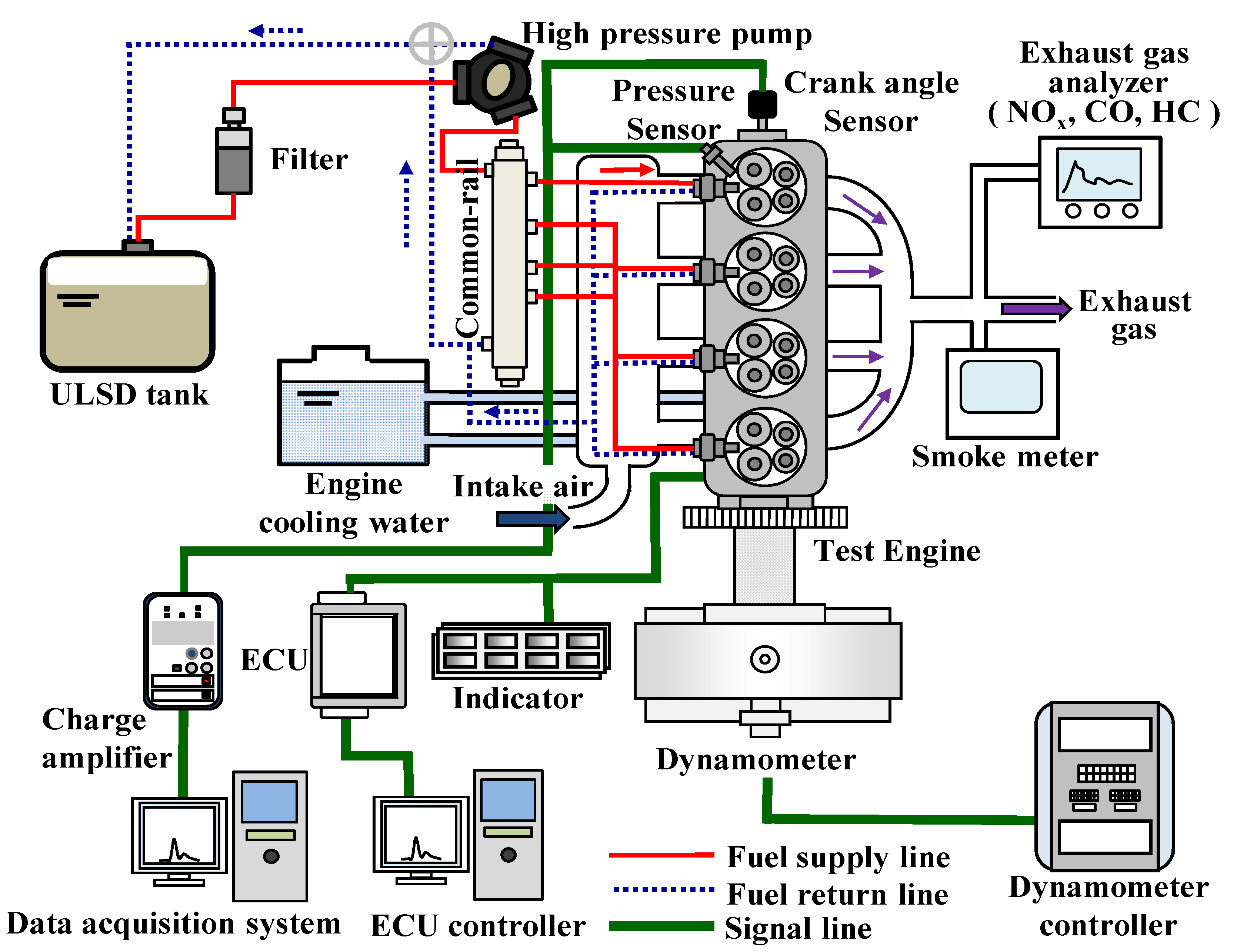
| Engine type | 4-stroke VGT DI diesel engine |
| Number of cylinder | 4 |
| Bore × Stroke (mm) | 77.2 × 84.5 |
| Displacement volume (L) | 1.582 |
| Compression ratio | 17.3 |
| Valve type | DOHC 4 valves per cylinder |
| Intake valve open (deg. BTDC) | 6 |
| Intake valve close (deg. ABDC) | 34 |
| Exhaust valve open (deg. BBDC) | 46 |
| Exhaust valve close (deg. ATDC) | 4 |
| Max. Power (kW/rpm) | 86/4000 |
| Max. Torque (Nm/rpm) | 260/2000 |
| Max. Speed (rpm) | 4750 |
2.2. Experimental Procedures
| Engine speed (rpm) and load(Nm) | 1500, 50 |
| Injection pressure (MPa) | 50~90 |
| Injection method | 1st and 2nd injection |
| First injection timing (deg. ATDC) | −70~−20 |
| Second injection timing (deg. ATDC) | −5, 5 |
| First injection quantity (mg/cycle) | 2~10 |
| Second injection quantity (mg/cycle) | Variable |
3. Results and Discussion
3.1. Effect of First Injection Quantity and Injection Timings

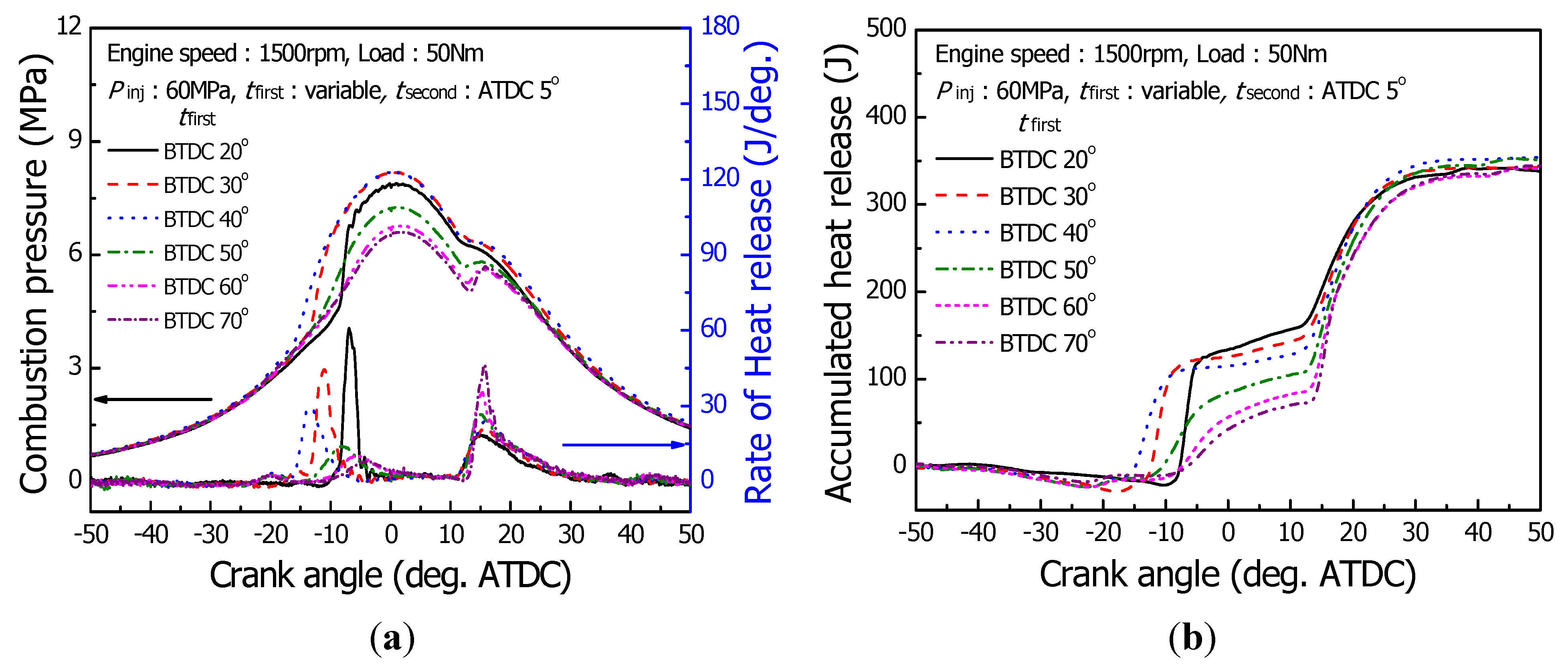

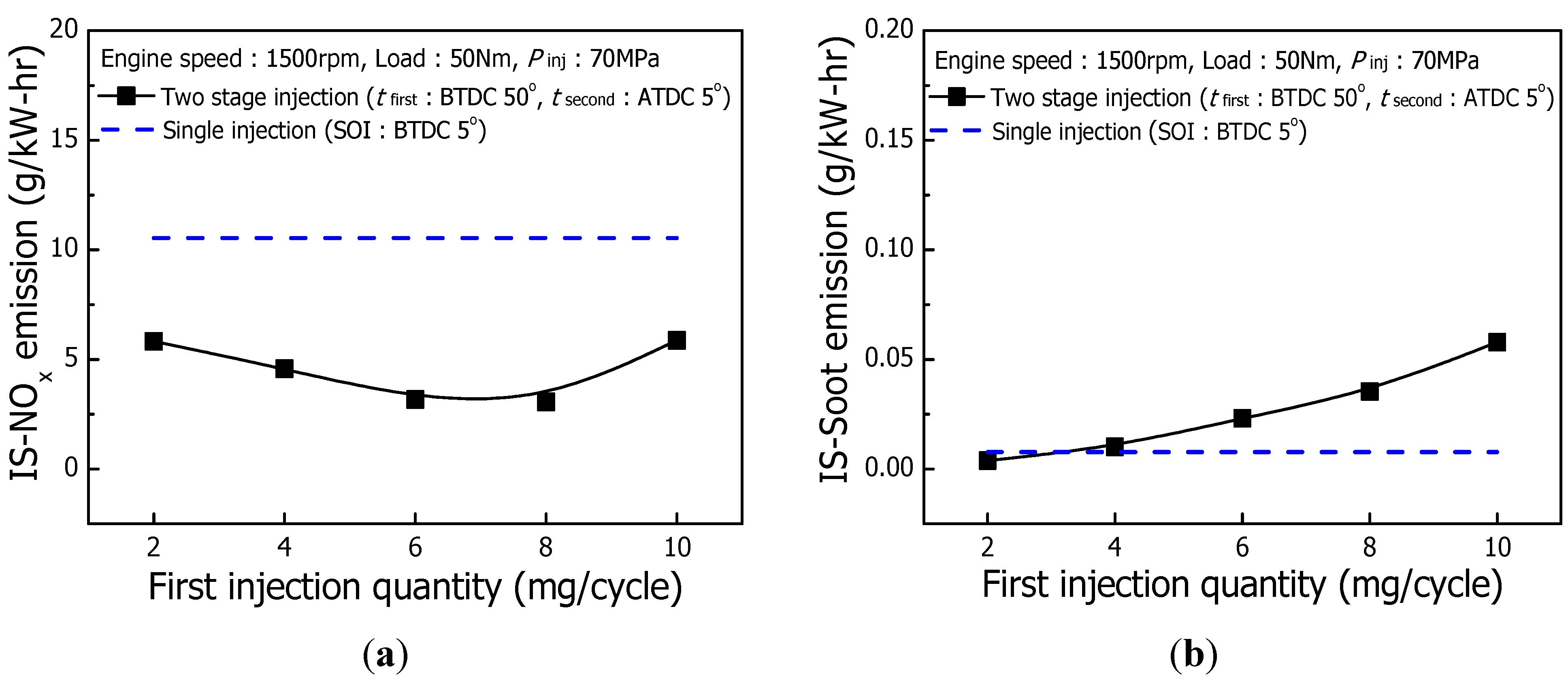
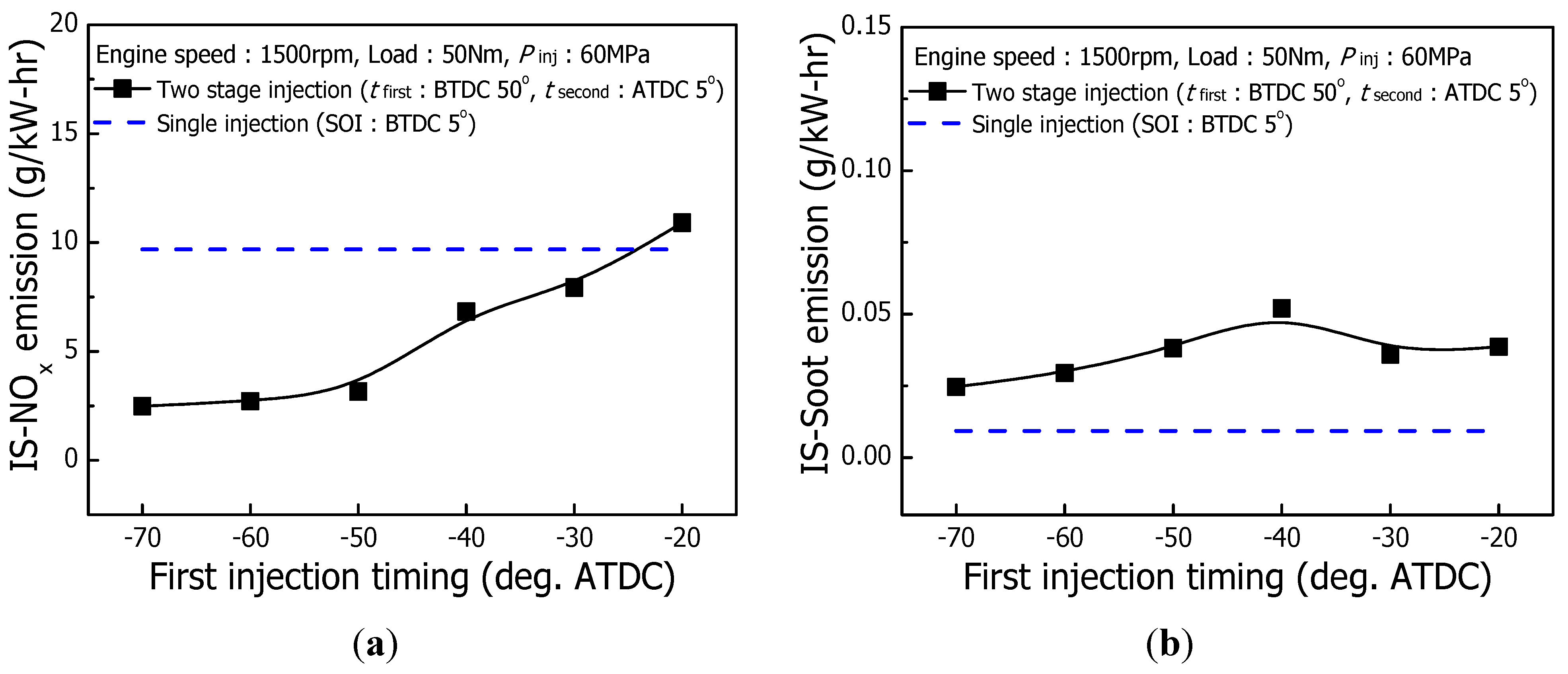

3.2. Effect of Injection Pressure
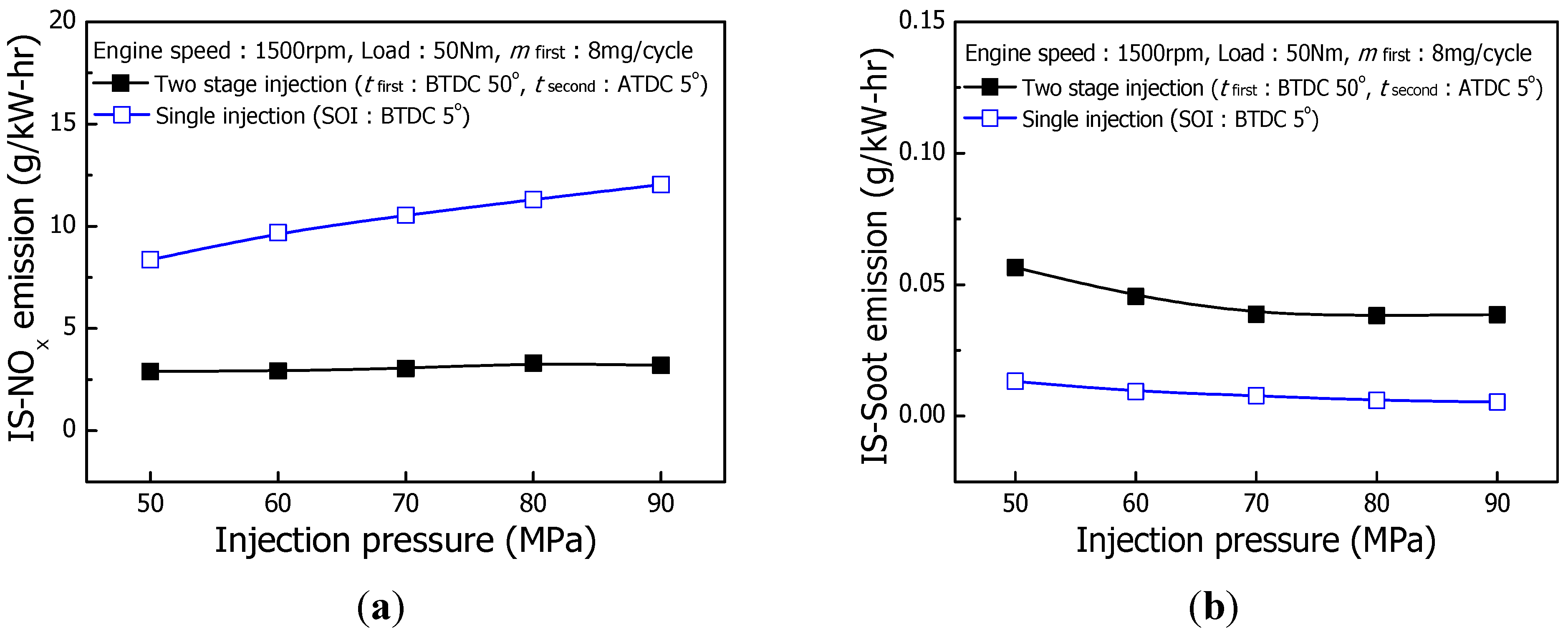
4. Conclusions
- The ignition delay with the TSC strategy was decreased with increased first injection mass. In addition, ISFC of TSC strategy was relatively increased compared to single injection because early injection is influenced on the insufficient combustion in the initial combustion duration. In the emission characteristics, when the first and second injection quantity is the same amount, IS-NOx emissions were remarkably reduced compared with the result of single injection. The IS-Soot emissions were similar to that of single injection.
- The combustion pressure of the first stage increased up to the injection timing of 40° BTDC, and decreased again after the injection timing of 40° BTDC. IS-NOx emissions were decreased in accordance with the advanced first injection timing compared to the single injection. However, there is a little effect on the IS-NOx emissions in the range from BTDC 50° to BTDC 70°. The result of IS-Soot emissions showed a similar trend under all tested conditions, and a slight effect on IS-Soot emission was observed regardless of the change in first injection timings. The effect of TSC strategy on IS-CO and IS-HC emission characteristics showed that both emissions were increased in accordance with the advance of first injection timing.
- IS-NOx emissions showed a lower concentration compared to single injection when the injection pressure is increased from 50 MPa to 90 MPa. Also, it can be seen that the IS-NOx emissions are reduced by an average of 70 percent compared to the result of the single injection. IS-Soot emissions applying the TSC strategy are higher than that of single injection. In addition, as the injection pressure increased, IS-Soot emissions are steadily reduced because of the improvement of fuel atomization by high-pressure injection.
Acknowledgment
References
- Lee, C.S.; Park, S.W. An experimental and numerical study on fuel atomization characteristics of high pressure diesel injection sprays. Fuel 2002, 81, 2417–2423. [Google Scholar] [CrossRef]
- Yoon, S.H.; Cha, J.P.; Lee, C.S. An investigation of the effects of spray angle and injection strategy on dimethyl ether (DME) combustion and exhaust emission characteristics in a common-rail diesel engine. Fuel Process. Technol. 2010, 91, 1364–1372. [Google Scholar] [CrossRef]
- Yokota, H.; Kudo, Y.; Nakajima, H.; Kakegawa, T.; Suzuki, T. A new concept for low emission diesel combustion. In Presented at International Congress & Exposition, Detroit, MI, USA, February 1997. [CrossRef]
- Helmantel, A.; Denbratt, I. HCCI operation of a passenger car common rail DI diesel engine with early injection of conventional diesel fuel. In Presented at SAE World Congress 2004, Detroit, MI, USA, March 8–11, 2004.
- Hasegawa, R.; Yanagihara, H. HCCI combustion in DI diesel engine. In Presented at SAE 2003 World Congress & Exhibitio, Detroit, MI, USA, March 2003. [CrossRef]
- Tanaka, S.; Ayala, F.; Keck, J.C.; Heywood, J.B. Two-stage ignition in HCCI combustion and HCCI control by fuels and additives. Combust. Flame 2003, 132, 219–239. [Google Scholar] [CrossRef]
- Kokjohn, S.L.; Reitz, R.D. A computational investigation of two-stage combustion in a light-duty engine. Available online: http://vcc-sae.org/abstracts/2363-computational-investigation-two-stage-combustion-light-duty-diesel-engine (accessed on 21 November 2011).
- Ebrahimi, R.; Desmet, B. An experimental investigation on engine speed and cyclic dispersion in an HCCI engine. Fuel 2010, 89, 2149–2156. [Google Scholar] [CrossRef]
- Starck, L.; Lecointe, B.; Forti, A.; Jeuland, N. Impact of fuel characteristics on HCCI combustion: Performances and emissions. Fuel 2010, 89, 3069–3077. [Google Scholar] [CrossRef]
- Opat, R.; Ra, Y.; Manuel, A.; Gonzalez, D.; Krieger, R.; Reitz, R.D.; Foster, D.E.; Durrett, R.P.; Siewert, R.M. Investigation of mixing and temperature effects on HC/CO emissions for highly dilute low temperature combustion in a light-duty diesel engine. In Presented at SAE World Congress & Exhibition, Detroit, MI, USA, April 2007. [CrossRef]
- Fang, T.; Coverdill, R.E.; Lee, C.-F.F.; White, R.A. Influence of injection parameters on the Transition from PCCI combustion to diffusion combustion in a small-bore HSDI diesel engine. Int. J. Automot. Technol. 2009, 10, 285–295. [Google Scholar] [CrossRef]
- Fang, T.; Lee, C.-F.F. Biodiesel effects on combustion processes in an HSDI diesel engine using advanced injection strategies. Proc. Combust. Inst. 2009, 32, 2785–2792. [Google Scholar] [CrossRef]
- Coverdill, R.E.; Lee, C.-F.F.; White, R.A. Low-Temperature combustion within a HSDI diesel engine using multiple-injection strategies. J. Eng. Gas Turbines Power 2009, 131, 062803:1–062803:8. [Google Scholar]
- Roh, H.G.; Lee, C.S. The effect of multiple injections on the stability of combustion and emissions characteristic in a passenger car diesel engine. Trans. KSAE 2007, 15, 76–82. [Google Scholar]
- Kanda, T.; Hakozaki, T.; Uchimoto, T.; Hatano, J.; Kitayama, N.; Sono, H. PCCI operation with early injection of conventional diesel fuel. In Presented at SAE 2005 World Congress & Exhibition, Detroit, MI, USA, April 2005. [CrossRef]
- Boot, M.D.; Luijten, C.C.M.; Rijk, E.P.; Albrecht, B.A.; Baert, D.S.G. Optimization of operating conditions in the early direct injection premixed charge compression ignition regime. In Presented at 9th International Conference on Engines and Vehicles, Naples, Italy, September 2009. [CrossRef]
- Benajes, J.; Molina, S.; Novella, R.; DeRudder, K. Influence of injection conditions and exhaust gas recirculation in a high-speed direct-injection diesel engine operating with a late split injection. Proc. Inst. Mech. Eng. Part D 2008, 222, 629–641. [Google Scholar] [CrossRef]
© 2011 by the authors; licensee MDPI, Basel, Switzerland. This article is an open access article distributed under the terms and conditions of the Creative Commons Attribution license ( http://creativecommons.org/licenses/by/3.0/).
Share and Cite
Jeong, K.; Lee, D.; Park, S.; Lee, C.S. Effect of Two-Stage Fuel Injection Parameters on NOx Reduction Characteristics in a DI Diesel Engine. Energies 2011, 4, 2049-2060. https://doi.org/10.3390/en4112049
Jeong K, Lee D, Park S, Lee CS. Effect of Two-Stage Fuel Injection Parameters on NOx Reduction Characteristics in a DI Diesel Engine. Energies. 2011; 4(11):2049-2060. https://doi.org/10.3390/en4112049
Chicago/Turabian StyleJeong, Kyusoo, Donggon Lee, Sungwook Park, and Chang Sik Lee. 2011. "Effect of Two-Stage Fuel Injection Parameters on NOx Reduction Characteristics in a DI Diesel Engine" Energies 4, no. 11: 2049-2060. https://doi.org/10.3390/en4112049





